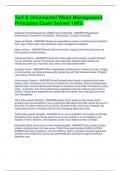Exam (elaborations)
Turf & Ornamental Weed Management Principles Exam Solved 100%
- Course
- Institution
Integrated Weed Managment (IWM) Control Methods - ANSWER-Regulations, Environment, Economics (Prevention, Mechanical, Cultural, Chemical) Origin of Weeds - ANSWER-Weeds are classified as native or introduced according to their origin. Plant origin may determine weed managment strategies. Nati...
[Show more]



